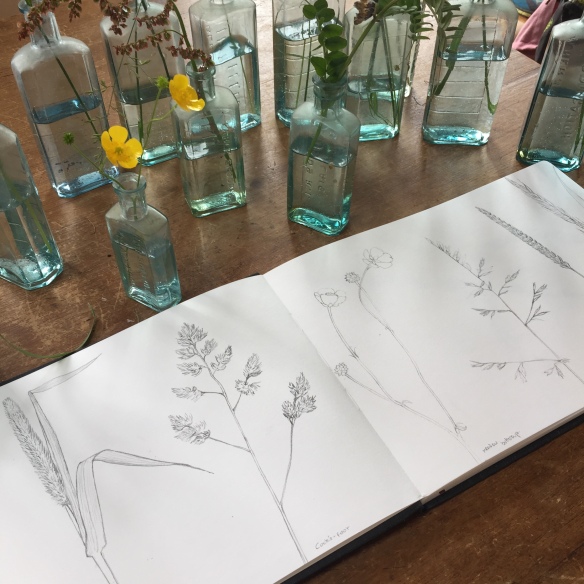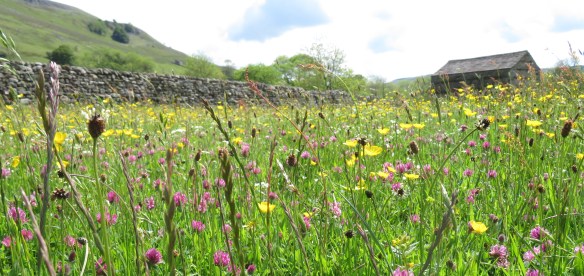For anyone that is new to my blog, I’m currently working on a project with the Dales Countryside Museum. I’ve been printing up their archive of Marie Hartley MBE’s wood engraving blocks that were used to illustrate her books about Swaledale, Wensleydale and Wharfedale written with Ella Pontefract. I’m now in the next phase of the project which is to carry out research in the form of looking at the archive of her notebooks, diaries and sketchbooks and going out ‘into the field’ to get inspiration for a new body of my own work to be exhibited at the museum gallery in 2020.

Today I’ve been sketching meadow grasses and flowers for reference for new prints inspired by the glorious upland meadows (of which the Yorkshire Dales National Park has a few). In the 1930s, Marie and Ella wrote about ‘haytime’ in the dales, of a time when whole communities were involved in the cutting and collecting of the hay, machinery was pulled by horses and the hay was then stored in the famous stone barns (often known as cow’us or laithe) ready for feeding the overwintering cattle and sheep.
(A selection of Marie Hartley’s wood engravings depicting aspects of hay making)
“When hay-time comes, generally towards the middle of July, everything else is put aside. All the women help, extra daughters appear miraculously from service. Irishmen are sometimes employed by farmers with small families. In a very wet summer much of the hay has to be left to rot in the fields, and some of the grass is never cut. When hay-time is well and safely over, a wave of relief goes through the upper dale”. (from Swaledale, 1934)
The meadows were not only fragrant, extremely beautiful and a rich source of food they were also very important ecosystems supporting a wide variety of invertebrates which were then fed on by numerous birds and animals. Unfortunately, as agricultural practises have changed and intensified, over the last fifty years 98% of meadows in the UK have been destroyed.

The Yorkshire Dales have also lost a proportion of their traditional meadows but, fortunately, due to the work of the Yorkshire Dales National Park Authority (YDNPA), Yorkshire Dales Millennium Trust (YDMT) and Natural England alongside committed farmers and landowners, the last twenty or so years has seen the conservation and restoration of species-rich meadows. This is a subject that I’ve been interested in since moving to the Yorkshire Dales and further information can be found at the websites of the YDMT & YDNPA. Times are very different now and ecology and economics mean that we’re unlikely to go back to the days of meadow-strewn Dales but what is being created is a network of species-rich meadows that everyone can benefit from and that are being managed with the help of modern machinery alleviating some of the hardships that the farming community of Marie’s time would have suffered. They are not only useful as a fodder crop of animals but attractive to wildlife, the local community and a visitor attraction which helps the local economy.
Due to Ella and Marie’s obvious love of the area, I’ve been visiting and revisiting locations around Kisdon fell (I am a fellrunner after all) which include Muker, Thwaite, Angram and Keld. The meadows at Muker, which have been given Coronation status, are currently at their most stunning.

This is the perfect time to visit. They are colourful and smell amazing, swallows and swifts swoop over them to feed on the many insects that they attract and there are so many different plant species. You can see yellow rattle, pignut, red clover, wood crane’s bill, eyebright, rough hawkbit, cat’s ear, meadow buttercups, lady’s mantle, crosswort, speedwell and melancholy thistle to name but a few!

“In this grave sweet valley of the Swale meadows like the flowery meads of medieval paintings burgeon in early summer. Perhaps nowhere else in the dale does the yellow of buttercups splash the fields more boldly, or the pink of crane’s-bill tinge them more deeply, or wayside bushes shower sprays of pink and white roses more freely than here round Gunnerside and Muker” so says Joan Ingilby and Marie Hartley in their book, The Yorkshire Dales, 1956.





Loved your description of the hay meadows. It brought back happy
memories of our visit to Muker with you a couple of weeks ago.
That was a brilliant day. I told Fiona (director of the museum) about our trip and how good it was to have two bird experts to identify everything. x
Pingback: Meadow Collection | Hester Cox: Printmaker